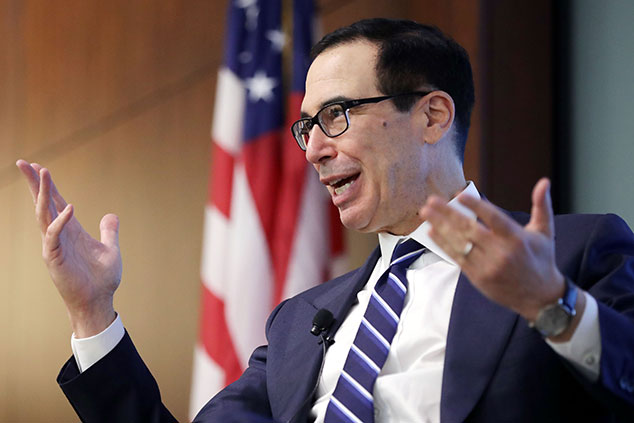
This article is taken from our FREE daily investment email Money Morning.
Every day, MoneyWeek’s executive editor John Stepek and guest contributors explain how current economic and political developments are affecting the markets and your wealth, and give you pointers on how you can profit.
Amid all the talk of trade disputes and surprise tariff hikes this week, markets paid little heed to something else going on.
Something that hasn’t happened since the dark days of 2009.
Something even more worrying that Donald Trump’s tariff tweets.
A nasty surprise for US bond markets
Earlier this week, the US Treasury department sold $27bn-worth of ten-year Treasury bonds at a bond auction.
What does that mean, in English?
The US government said: “We need to borrow $27bn and we need to hang onto it for the next ten years.” Investors then said: “We will lend you this money at x% interest a year.” The US government took the best offers and gave the winners IOUs (US government bonds, also known as Treasuries).
This happens all the time. So what was significant about this particular auction?
Well, the issue is that, on this occasion, demand for the bonds was very low compared to usual. People normally queue up to lend the US money, because the US is such a good credit risk. US Treasuries are deemed to be pretty much the world’s safest assets.
But this time, the “bid-to-cover” ratio was extremely low at 2.17. That means that there was still twice as much demand for the bonds as there were bonds to go around, but that’s the lowest bid-to-cover since March 2009, reports Bloomberg.
It could be a one-off (although it’s worth noting that demand for $19bn-worth of 30-year debt on Thursday was also weak).
It could be that yields have fallen too low (due to recent scares over trade and the global growth slowdown) and simply weren’t sufficiently attractive. It could be to do with the cost of hedging foreign currency exposure (put simply, it no longer pays for overseas investors to buy Treasuries because of the cost of protecting against moves in the dollar against their own currencies).
Or – and this is the big worry – it could be that investors are starting to pay attention to the fact that the US’s public finances look ugly, and to the fact that no one has any intention of getting to grips with that. Indeed, they are only going to get uglier over the foreseeable future.
Why the frail US finances could mean a weaker US dollar
The US national debt is high and rising. It’s more than doubled to over $22trn since before the financial crisis. By the end of this quarter, debt is expected to hit 108% of GDP, which is chunky. (The UK by comparison, is below 85%, which in the days before the financial crisis, would have been considered worrying.)
That’s the highest it’s been since World War II.
The thing is, no one cares. Worrying about the national debt is so last decade, if not last century. Why? Because we’ve got central banks. Central banks can take care of anything. Indeed, the hot “new” (I say “new” because it’s actually really pretty old) idea in politics is that economies can print as much money as they want to fund spending, and can therefore never go bust.
(Modern Monetary Theory – MMT – advocates do point out that inflation is the limiting factor here, but most of them don’t seem to view it as being a problem that can’t be dealt with as and when it arises, which strikes me as deliberately naive.)
That said, it is true that a country with its own currency and its own central bank does not have to ever default on its debts. It can always repay them with printed money, regardless of whether that printed money actually has any value or not.
The big “but” here is that the central bank has to be willing to fund this spending. As of right now, Fed boss Jerome Powell simply doesn’t seem to be all that keen to end quantitative tightening (QT), let alone restart quantitative easing (QE), or lower interest rates.
Louis-Vincent Gave at Gavekal even suggests that this could be one reason for Trump’s trade tweets. The US is set to go to market for another $1.3trn or more this year. If bond markets are already choking on that issuance, then you can start to see why Trump is so keen for the Fed to get out the printing press again.
As Gave puts it, America’s financial state “is so ugly that it is hard to avoid the conclusion that the Fed will soon have to (once again) monetise US government spending.”
For now, it’s clearly not a problem – US yields are very low. But, as Gave points out, despite the current “risk-off” mentality, the US dollar has not strengthened greatly (which is what normally happens).
Is it possible that investors are starting to take note – not only of America’s ropey public finances, but also of the fact that politicians of all stripes are promising to make them even worse? If anything can undermine the dollar in the long run, it’s inflationary public policy combined with inflationary monetary policy.
It’ll take a while to get there. But once the story changes, things could move fast. We discussed the long-term fragilities of the US dollar – and what it could all mean for investors – in a recent issue of MoneyWeek magazine. If you’re not already a subscriber, get your first six issues free here.